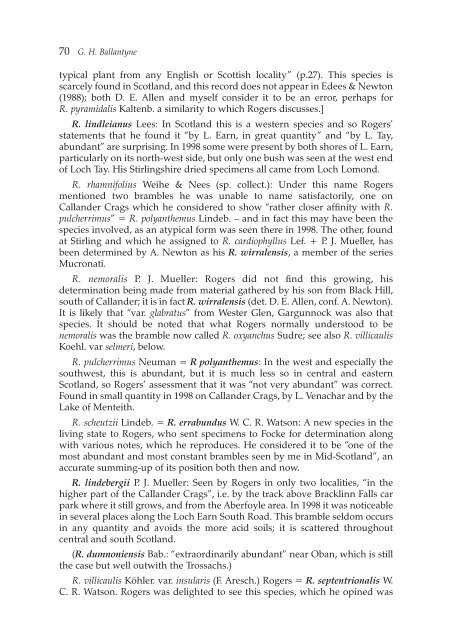the Forth Naturalist Historian - Forth Naturalist and Historian ...
the Forth Naturalist Historian - Forth Naturalist and Historian ...
the Forth Naturalist Historian - Forth Naturalist and Historian ...
You also want an ePaper? Increase the reach of your titles
YUMPU automatically turns print PDFs into web optimized ePapers that Google loves.
70 G. H. Ballantyne<br />
typical plant from any English or Scottish locality” (p.27). This species is<br />
scarcely found in Scotl<strong>and</strong>, <strong>and</strong> this record does not appear in Edees & Newton<br />
(1988); both D. E. Allen <strong>and</strong> myself consider it to be an error, perhaps for<br />
R. pyramidalis Kaltenb. a similarity to which Rogers discusses.]<br />
R. lindleianus Lees: In Scotl<strong>and</strong> this is a western species <strong>and</strong> so Rogers’<br />
statements that he found it “by L. Earn, in great quantity” <strong>and</strong> “by L. Tay,<br />
abundant” are surprising. In 1998 some were present by both shores of L. Earn,<br />
particularly on its north-west side, but only one bush was seen at <strong>the</strong> west end<br />
of Loch Tay. His Stirlingshire dried specimens all came from Loch Lomond.<br />
R. rhamnifolius Weihe & Nees (sp. collect.): Under this name Rogers<br />
mentioned two brambles he was unable to name satisfactorily, one on<br />
Call<strong>and</strong>er Crags which he considered to show “ra<strong>the</strong>r closer affinity with R.<br />
pulcherrimus” = R. polyan<strong>the</strong>mus Lindeb. – <strong>and</strong> in fact this may have been <strong>the</strong><br />
species involved, as an atypical form was seen <strong>the</strong>re in 1998. The o<strong>the</strong>r, found<br />
at Stirling <strong>and</strong> which he assigned to R. cardiophyllus Lef. + P. J. Mueller, has<br />
been determined by A. Newton as his R. wirralensis, a member of <strong>the</strong> series<br />
Mucronati.<br />
R. nemoralis P. J. Mueller: Rogers did not find this growing, his<br />
determination being made from material ga<strong>the</strong>red by his son from Black Hill,<br />
south of Call<strong>and</strong>er; it is in fact R. wirralensis (det. D. E. Allen, conf. A. Newton).<br />
It is likely that “var. glabratus” from Wester Glen, Gargunnock was also that<br />
species. It should be noted that what Rogers normally understood to be<br />
nemoralis was <strong>the</strong> bramble now called R. oxyanchus Sudre; see also R. villicaulis<br />
Koehl. var selmeri, below.<br />
R. pulcherrimus Neuman = R polyan<strong>the</strong>mus: In <strong>the</strong> west <strong>and</strong> especially <strong>the</strong><br />
southwest, this is abundant, but it is much less so in central <strong>and</strong> eastern<br />
Scotl<strong>and</strong>, so Rogers’ assessment that it was “not very abundant” was correct.<br />
Found in small quantity in 1998 on Call<strong>and</strong>er Crags, by L. Venachar <strong>and</strong> by <strong>the</strong><br />
Lake of Menteith.<br />
R. scheutzii Lindeb. = R. errabundus W. C. R. Watson: A new species in <strong>the</strong><br />
living state to Rogers, who sent specimens to Focke for determination along<br />
with various notes, which he reproduces. He considered it to be “one of <strong>the</strong><br />
most abundant <strong>and</strong> most constant brambles seen by me in Mid-Scotl<strong>and</strong>”, an<br />
accurate summing-up of its position both <strong>the</strong>n <strong>and</strong> now.<br />
R. lindebergii P. J. Mueller: Seen by Rogers in only two localities, “in <strong>the</strong><br />
higher part of <strong>the</strong> Call<strong>and</strong>er Crags”, i.e. by <strong>the</strong> track above Bracklinn Falls car<br />
park where it still grows, <strong>and</strong> from <strong>the</strong> Aberfoyle area. In 1998 it was noticeable<br />
in several places along <strong>the</strong> Loch Earn South Road. This bramble seldom occurs<br />
in any quantity <strong>and</strong> avoids <strong>the</strong> more acid soils; it is scattered throughout<br />
central <strong>and</strong> south Scotl<strong>and</strong>.<br />
(R. dumnoniensis Bab.: “extraordinarily abundant” near Oban, which is still<br />
<strong>the</strong> case but well outwith <strong>the</strong> Trossachs.)<br />
R. villicaulis Köhler. var. insularis (F. Aresch.) Rogers = R. septentrionalis W.<br />
C. R. Watson. Rogers was delighted to see this species, which he opined was



